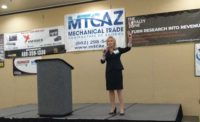Providing a comfortable environment for Monticello visitors is important, but the hvac system is critical to preserving the structure and the priceless artifacts found within. Mike Merriam, director of facilities planning and construction at Monticello, said, "We strive to maintain constant temperature and humidity to preserve the very important collection of furnishings and artifacts.
“In addition to many of Jefferson’s personal belongings and furniture are artifacts brought back from the Lewis and Clark expedition, numerous books and paintings, and a collection of musical instruments. We don’t want it too humid or too dry. We try to maintain 70 degrees and 50 percent relative humidity in the home.”
Monticello was first air conditioned in 1954, but the hvac system had not been significantly upgraded until 1994. It now uses a chilled water system consisting of a 50-ton Trane scroll compressor chiller and a Trane Modular Climate Changer™ air handler. Greenwood Partnership, Lynchburg, VA, provided engineering support while Sullivan Mechanical Contractors, Shenandoah, VA, installed the chiller and air handler.
Authenticity and originality in all aspects of Monticello’s presentation to the public are chief concerns of the staff. The chiller is located in the basement area of the gift shop, about 400 ft from the home. Special low-profile refrigerant condensing units are located on the gift shop roof behind a facade so as not to be visible to Monticello visitors.
The chiller produces 41 degrees F chilled water that is pumped to the home via underground water pipes. The air handler and its chilled water cooling coil are located in the basement of the home. The modular design made it easier to get the air handler modules into the basement equipment room for final assembly, although one of the modules had to be further disassembled to fit through the door. Air distribution is accomplished via the 1954 ductwork installed in the original, but no longer used, indoor privy ventilation shafts.
Small slot diffusers strategically located throughout the home, and nearly invisible to visitors, distribute air to maintain museum-class temperature and humidity control. Return air is drawn from conditioned spaces through the original fireplaces. This clever air distribution scheme maintains the home’s authenticity.
Merriam noted that the 50-ton chiller is equipped with dual refrigerant circuits for redundancy. Each chiller circuit provides 25 tons of cooling capacity. Thus with a maximum anticipated load of 30 tons at Monticello, Merriam has enough chiller capacity to maintain temperature and humidity control in all but the most extreme hot weather if one of the refrigerant circuits or compressors should fail. Back-up water pumps and electric generators provide further protection in the event of an electrical outage.
Another challenge in air conditioning Monticello is the result of Jefferson’s love of large amounts of natural light. As a result, there are many large, single-pane windows. This makes proper temperature and humidity control especially important to prevent condensation on the windows, which could cause the window sashes to rot.
With more than 50,000 people visiting Monticello every year, each one bringing in a bit of dust on clothing and shoes, air filtration is another critical need as such dust could become a real problem. The air handler is equipped with 95% filters that are effective in removing the dust particles.
Merriam was previously a planner with the facilities division of the University of Virginia, where he first became involved with historic buildings. He learned building management, plumbing, and mechanical skills during a 15-year career in the building trades. Merriam said that it is a thrill to be responsible for the buildings at Monticello, adding, “It is great to be able to work for an organization that combines concern for the site and its preservation with good business practices. There is important preservation and education going on here that is backed up by good management.”
Publication date: 12/10/2001









